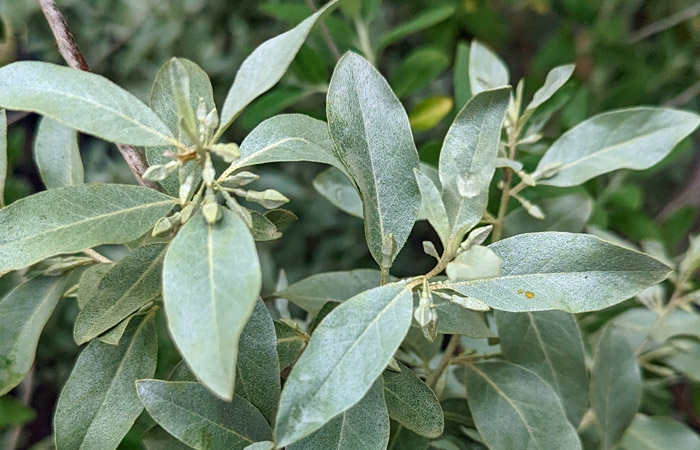Trees are green. We learn this in kindergarten. Plants over all grow green leaves. But what about when they don’t? Norway maples, Chokecherries, and Flowering Crabapples are known for their red to purple foliage all summer long. There is even a Willow, who’s name I cannot recall, that keep yellow leave all season in warmer climates?
Then there are the trees with silver to white leaves. Many of us have seen the Silver Poplar with its velvety white leaves. Silver maple also has a measure of white on the back of its foliage. Russian Olive also fits the category of silver trees but is often pushed aside or excluded. It has been commonly planted throughout southeast Manitoba for years but is increasingly falling out of favor for a few reasons. It has a habit of becoming invasive via seedlings from their small, inedible olives and suckering roots. It has an impressive tolerance for drought and a wide range of soils tolerances due to its ability to produce its own nitrogen, similar to Caragana’s. It does suffer from spontaneous branch freezing and death in windy locations. This often results in them becoming misshapen, lopsided, and scraggly looking as they mature. Add this to their prickly nature as they grow some scattered thorns. With its low and somewhat unpredictable branching, they are hard to prune into shape. I tried this once with my mother-in-law’s Russian Olive. I still feel sheepish every time I see it. However, we cannot ignore the silver foliage, yellow spring flowers, deer resistance and over all versatility of the Russian Olive. We are, after all, quite limited in what we can grow here due to our savage and harsh winters.
Beggars can’t be choosers! I have often redirected customers to the Silky White Willow when looking for a silver tree. It has similar leaf shape and colour but grows taller. It also produces white, fluffy seeds in June and requires a lower wetter planting location than the olive, making them environmental opposites.
We now have a third option. A new player in the game introduced by Jeffries nursery. Silverado Hybrid Olive. A selection of Russian Olive crossed with the Wolf Willow. I had the look into this process because that did not sound possible. Once again, plants given inaccurate names makes my job so… much… harder. Turn out the Wolf Willow is not actually a Willow! It is a native Olive variety also known as Silverberry and is a cousin to the Buffaloberry. Wolf Willow Berries can be used for making essential oils and the yellow and red striped seeds have been used as beads for necklaces. The Wolf Willow, found by your local drainage ditch, is an under rated and under used plant due to its suckering nature and lack of desirable properties. It can however produce its own nitrogen like the Russian Olive and only grow to 6′ tall. Once it was crossed with the Russian Olive it was given new purpose. The Silverado Olive grows to 10′ tall and wide with the silver foliage and yellow spring flowers of both its parents but with no fruit and limited suckering. It also has the resilience of its parents for soil, cold and drought tolerance. Its size makes it flexible to grow as a large shrub or can be trimmed to be a hedge or a multi stem mini tree. While the concept of a 10′ silver hedge is striking, I personally look forward to trying it out as a silver mini tree. But… where on earth will I put it…?




